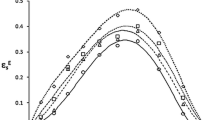Abstract
The aggregation of some aldehydes in nonpolar solvents was investigated using the static dielectric method. The molecular association of acetone and two of its derivatives (acetophenone and benzophenone) in cyclohexane solvent were also investigated by this method. Analysis of the static dielectric data for solution of these materials indicated a high molecular association. It was found that benzaldehyde and its derivatives have a strong tendency for antiparallel molecular association, whereas acetone and its derivatives have a tendency for parallel alignment. The experimental results show that there is a sensitive relationship between the molecular association and molecular structure of these materials. The influence of solvent on the molecular association of the solute molecules was studied and compared.
Similar content being viewed by others
REFERENCES
J. W. Smith, Electric Dipole Moment (Butterworths, London, 1955).
W. Dannhauser and A. F. Flueckinger, J. Phys. Chem. 68, 1814(1964).
D. A. Dunmur and K. Toriyama, Liquid Crystallogr. 1, 169(1986).
G. M. Janini and A. H. Katrib, J. Chem. Education 60, 1087(1983).
A. Ghanadzadeh, M. S. Beevers, J. Mol. Liquids 102, 365(2003).
A. Ghanadzadeh, M. S. Beevers, J. Mol. Liquids 100, 47(2002).
P. J. A. Ribeiro-Claro, L. A. E. Batista de Carvalho, and A. M. Amado, J. Raman Spectrosc. 28, 867(1997).
N. Karger, A. M. Amorim da Costa, and P. J. A. Ribeiro-Claro, J. Phys. Chem. A 103, 8672(1999).
M. P. M. Marques, A. M. Amorim da Costa, and P. J. A. Ribeiro-Claro, J. Phys. Chem. A 105, 5292(2001).
V. Madhurima, N. Sathyan, V. R. K. Murthy, and J. Sobhanadri, Spectrochim. Acta A 54, 299(1998).
K. Rajagopal, T. A. Parasada Rao, V. Madhurima, and J. Sobhanadri, J. Mol. Liquids 76, 13(1998).
H. Frohlich, Theory of Dielectrics (Oxford University Press, London, 1949).
J. G. Kirkwood, J. Chem. Phys. 7, 911(1939).
L. Onsager, J. Amer. Chem. Soc. 58, 1486(1936).
C. P. Smyth Molecular Interactions, Vol. II (Wiley, New york, 1980).
C. J. F. Bottcher, Theory of Electric Polarisation, Vol. I (Elsevier, New York, 1973).
A. Ghanadzadeh, Ph.D. Thesis, Aston University, Birmigham, UK (1995).
E. A. Guggenheim, Trans. Faraday Soc. 45, 714(1949).
A. L. McClellan, Tables of Experimental Dipole Moments (Freeman, San Francisco, 1963).
J. A. Dean, Lange's Handbook of Chemistry (MacGraw-Hill, New York, 1992).
CRC, Handbook of Chemistry and Physics, 59th edn. (CRC Press, Boca Raton, 1978-1979).
Author information
Authors and Affiliations
Rights and permissions
About this article
Cite this article
Gilani, A.G., Mamaghani, M. & Anbir, L. Dipole Moments and Intermolecular Association of Some Carbonyl Compounds in Nonpolar Solvents. Journal of Solution Chemistry 32, 625–636 (2003). https://doi.org/10.1023/A:1026344422952
Issue Date:
DOI: https://doi.org/10.1023/A:1026344422952



